Enron Case Study: Examining Corporate Culture, Ethics, and Bankruptcy
VerifiedAdded on 2023/01/24
|8
|2019
|42
Case Study
AI Summary
This case study delves into the Enron scandal, examining how the company's corporate culture, characterized by arrogance, internal rivalry, and a 'rank and yank' performance evaluation system, contributed to its eventual bankruptcy. The analysis highlights the roles played by Enron's bankers, auditors (Arthur Andersen), and attorneys in facilitating the company's unethical practices through questionable accounting methods and special purpose entities. Specifically, the chief financial officer's (Andrew Fastow) use of SPEs to conceal debt and manipulate financial statements is scrutinized. The study also references biblical verses to underscore the ethical implications of the actions taken by Enron's executives, emphasizing the importance of strong ethical principles in business leadership. Desklib provides access to similar case studies and solved assignments for students.
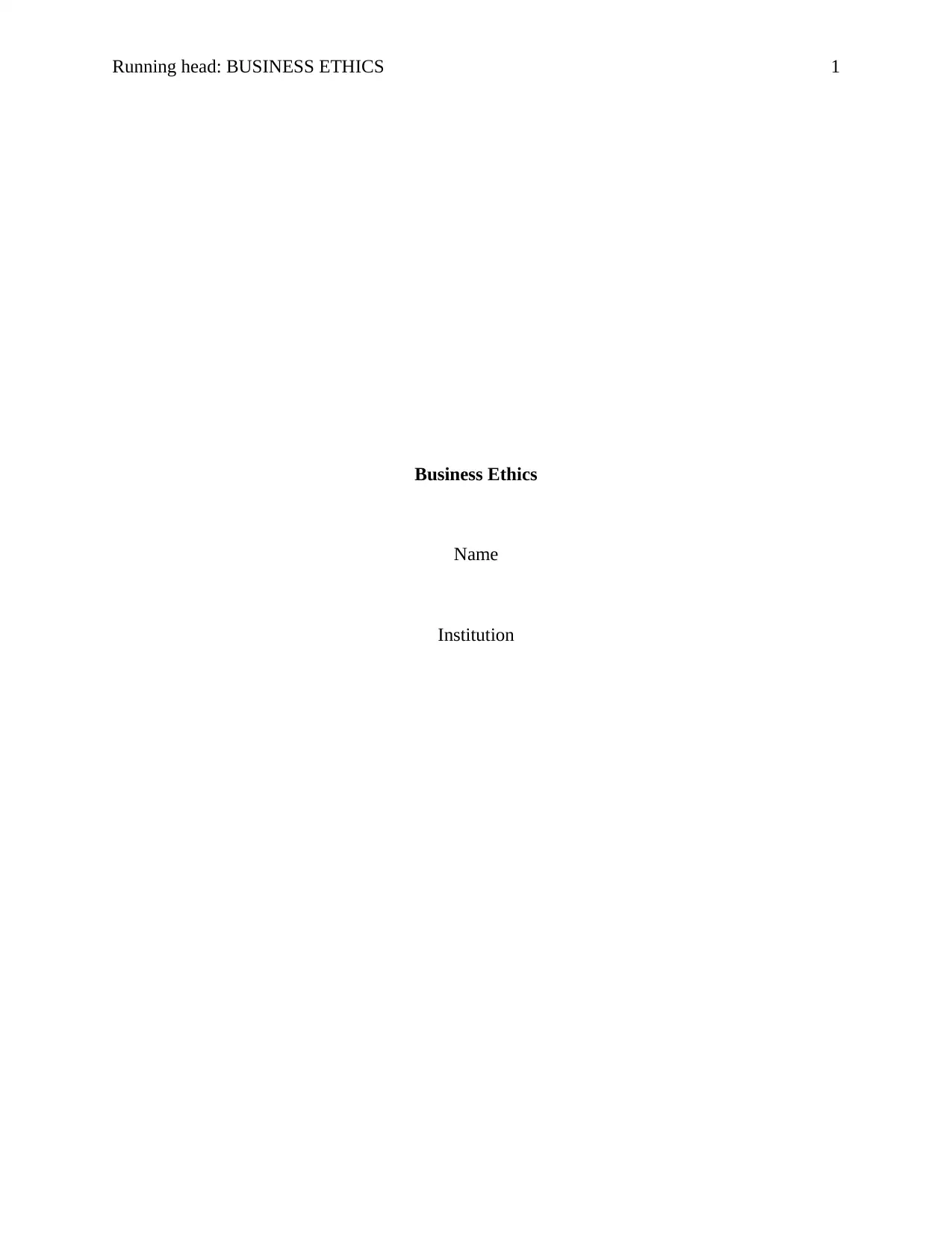
Running head: BUSINESS ETHICS 1
Business Ethics
Name
Institution
Business Ethics
Name
Institution
Secure Best Marks with AI Grader
Need help grading? Try our AI Grader for instant feedback on your assignments.
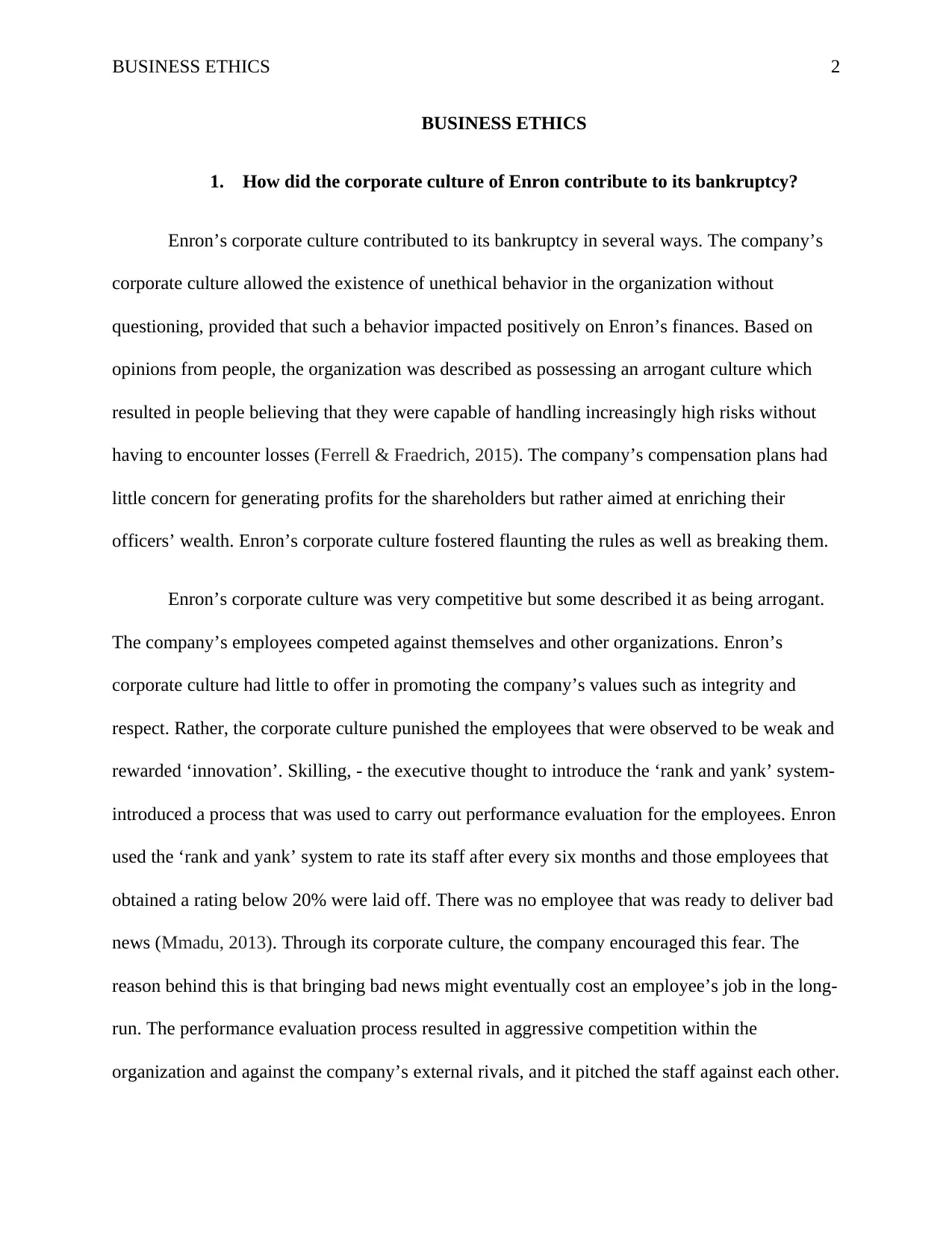
BUSINESS ETHICS 2
BUSINESS ETHICS
1. How did the corporate culture of Enron contribute to its bankruptcy?
Enron’s corporate culture contributed to its bankruptcy in several ways. The company’s
corporate culture allowed the existence of unethical behavior in the organization without
questioning, provided that such a behavior impacted positively on Enron’s finances. Based on
opinions from people, the organization was described as possessing an arrogant culture which
resulted in people believing that they were capable of handling increasingly high risks without
having to encounter losses (Ferrell & Fraedrich, 2015). The company’s compensation plans had
little concern for generating profits for the shareholders but rather aimed at enriching their
officers’ wealth. Enron’s corporate culture fostered flaunting the rules as well as breaking them.
Enron’s corporate culture was very competitive but some described it as being arrogant.
The company’s employees competed against themselves and other organizations. Enron’s
corporate culture had little to offer in promoting the company’s values such as integrity and
respect. Rather, the corporate culture punished the employees that were observed to be weak and
rewarded ‘innovation’. Skilling, - the executive thought to introduce the ‘rank and yank’ system-
introduced a process that was used to carry out performance evaluation for the employees. Enron
used the ‘rank and yank’ system to rate its staff after every six months and those employees that
obtained a rating below 20% were laid off. There was no employee that was ready to deliver bad
news (Mmadu, 2013). Through its corporate culture, the company encouraged this fear. The
reason behind this is that bringing bad news might eventually cost an employee’s job in the long-
run. The performance evaluation process resulted in aggressive competition within the
organization and against the company’s external rivals, and it pitched the staff against each other.
BUSINESS ETHICS
1. How did the corporate culture of Enron contribute to its bankruptcy?
Enron’s corporate culture contributed to its bankruptcy in several ways. The company’s
corporate culture allowed the existence of unethical behavior in the organization without
questioning, provided that such a behavior impacted positively on Enron’s finances. Based on
opinions from people, the organization was described as possessing an arrogant culture which
resulted in people believing that they were capable of handling increasingly high risks without
having to encounter losses (Ferrell & Fraedrich, 2015). The company’s compensation plans had
little concern for generating profits for the shareholders but rather aimed at enriching their
officers’ wealth. Enron’s corporate culture fostered flaunting the rules as well as breaking them.
Enron’s corporate culture was very competitive but some described it as being arrogant.
The company’s employees competed against themselves and other organizations. Enron’s
corporate culture had little to offer in promoting the company’s values such as integrity and
respect. Rather, the corporate culture punished the employees that were observed to be weak and
rewarded ‘innovation’. Skilling, - the executive thought to introduce the ‘rank and yank’ system-
introduced a process that was used to carry out performance evaluation for the employees. Enron
used the ‘rank and yank’ system to rate its staff after every six months and those employees that
obtained a rating below 20% were laid off. There was no employee that was ready to deliver bad
news (Mmadu, 2013). Through its corporate culture, the company encouraged this fear. The
reason behind this is that bringing bad news might eventually cost an employee’s job in the long-
run. The performance evaluation process resulted in aggressive competition within the
organization and against the company’s external rivals, and it pitched the staff against each other.
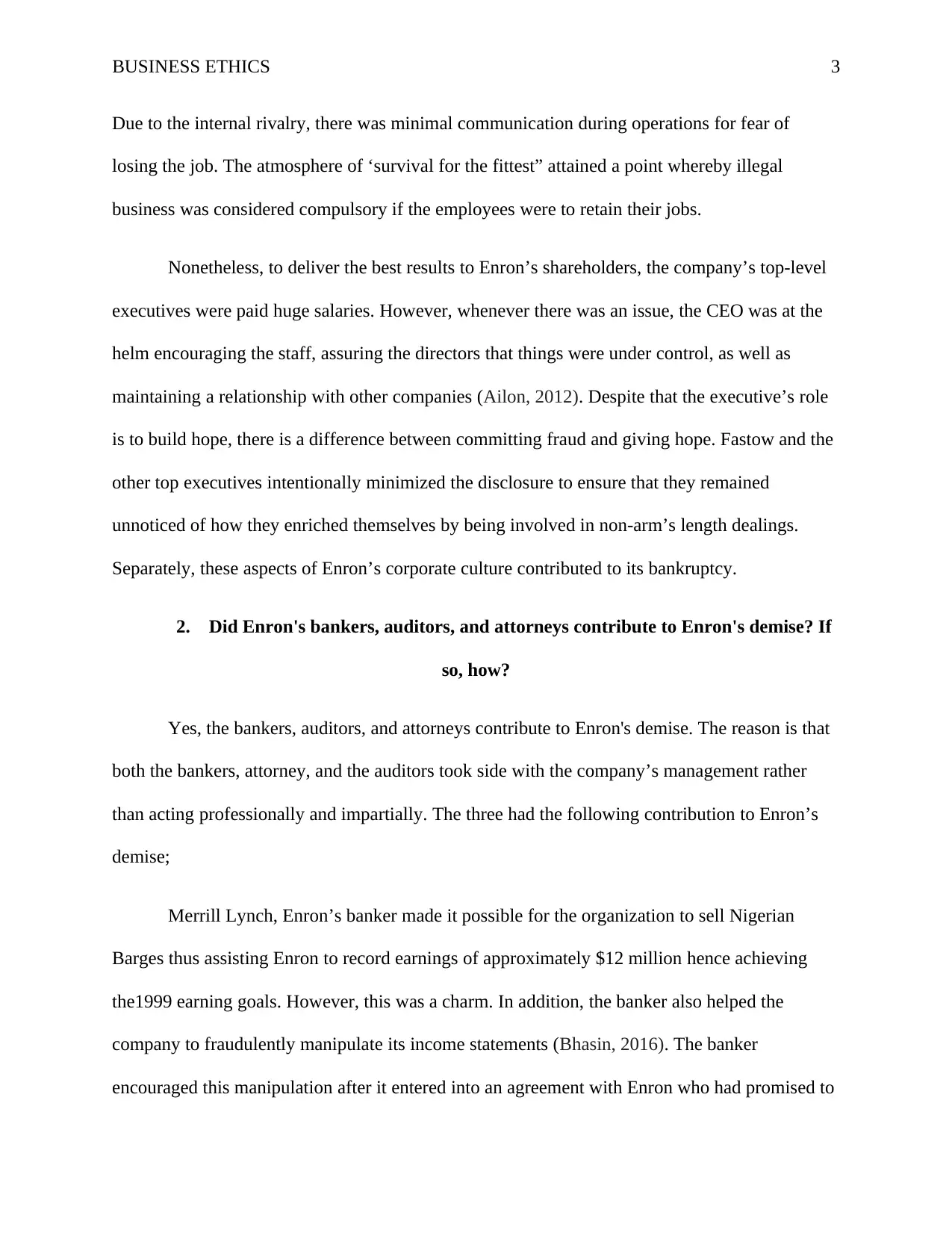
BUSINESS ETHICS 3
Due to the internal rivalry, there was minimal communication during operations for fear of
losing the job. The atmosphere of ‘survival for the fittest” attained a point whereby illegal
business was considered compulsory if the employees were to retain their jobs.
Nonetheless, to deliver the best results to Enron’s shareholders, the company’s top-level
executives were paid huge salaries. However, whenever there was an issue, the CEO was at the
helm encouraging the staff, assuring the directors that things were under control, as well as
maintaining a relationship with other companies (Ailon, 2012). Despite that the executive’s role
is to build hope, there is a difference between committing fraud and giving hope. Fastow and the
other top executives intentionally minimized the disclosure to ensure that they remained
unnoticed of how they enriched themselves by being involved in non-arm’s length dealings.
Separately, these aspects of Enron’s corporate culture contributed to its bankruptcy.
2. Did Enron's bankers, auditors, and attorneys contribute to Enron's demise? If
so, how?
Yes, the bankers, auditors, and attorneys contribute to Enron's demise. The reason is that
both the bankers, attorney, and the auditors took side with the company’s management rather
than acting professionally and impartially. The three had the following contribution to Enron’s
demise;
Merrill Lynch, Enron’s banker made it possible for the organization to sell Nigerian
Barges thus assisting Enron to record earnings of approximately $12 million hence achieving
the1999 earning goals. However, this was a charm. In addition, the banker also helped the
company to fraudulently manipulate its income statements (Bhasin, 2016). The banker
encouraged this manipulation after it entered into an agreement with Enron who had promised to
Due to the internal rivalry, there was minimal communication during operations for fear of
losing the job. The atmosphere of ‘survival for the fittest” attained a point whereby illegal
business was considered compulsory if the employees were to retain their jobs.
Nonetheless, to deliver the best results to Enron’s shareholders, the company’s top-level
executives were paid huge salaries. However, whenever there was an issue, the CEO was at the
helm encouraging the staff, assuring the directors that things were under control, as well as
maintaining a relationship with other companies (Ailon, 2012). Despite that the executive’s role
is to build hope, there is a difference between committing fraud and giving hope. Fastow and the
other top executives intentionally minimized the disclosure to ensure that they remained
unnoticed of how they enriched themselves by being involved in non-arm’s length dealings.
Separately, these aspects of Enron’s corporate culture contributed to its bankruptcy.
2. Did Enron's bankers, auditors, and attorneys contribute to Enron's demise? If
so, how?
Yes, the bankers, auditors, and attorneys contribute to Enron's demise. The reason is that
both the bankers, attorney, and the auditors took side with the company’s management rather
than acting professionally and impartially. The three had the following contribution to Enron’s
demise;
Merrill Lynch, Enron’s banker made it possible for the organization to sell Nigerian
Barges thus assisting Enron to record earnings of approximately $12 million hence achieving
the1999 earning goals. However, this was a charm. In addition, the banker also helped the
company to fraudulently manipulate its income statements (Bhasin, 2016). The banker
encouraged this manipulation after it entered into an agreement with Enron who had promised to
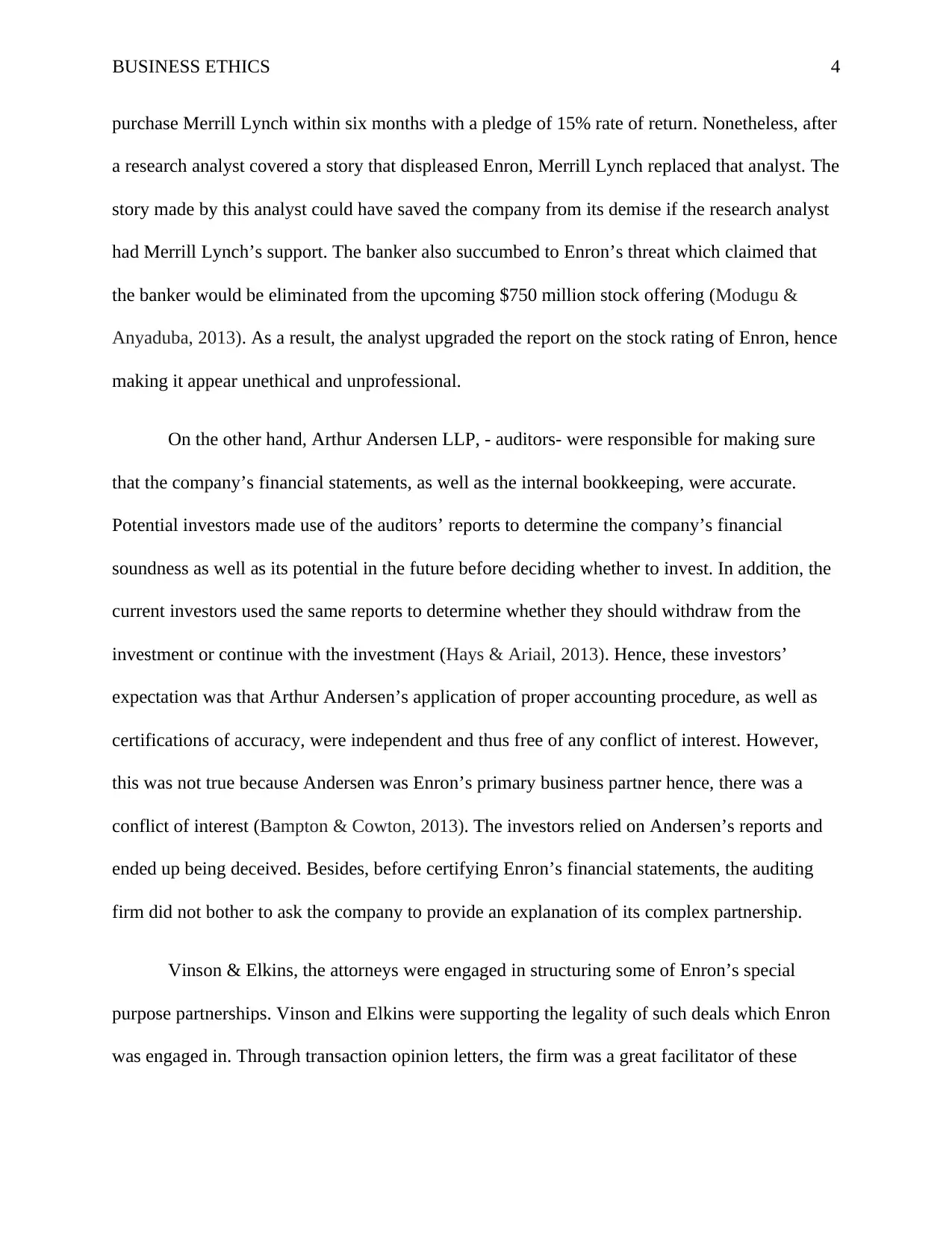
BUSINESS ETHICS 4
purchase Merrill Lynch within six months with a pledge of 15% rate of return. Nonetheless, after
a research analyst covered a story that displeased Enron, Merrill Lynch replaced that analyst. The
story made by this analyst could have saved the company from its demise if the research analyst
had Merrill Lynch’s support. The banker also succumbed to Enron’s threat which claimed that
the banker would be eliminated from the upcoming $750 million stock offering (Modugu &
Anyaduba, 2013). As a result, the analyst upgraded the report on the stock rating of Enron, hence
making it appear unethical and unprofessional.
On the other hand, Arthur Andersen LLP, - auditors- were responsible for making sure
that the company’s financial statements, as well as the internal bookkeeping, were accurate.
Potential investors made use of the auditors’ reports to determine the company’s financial
soundness as well as its potential in the future before deciding whether to invest. In addition, the
current investors used the same reports to determine whether they should withdraw from the
investment or continue with the investment (Hays & Ariail, 2013). Hence, these investors’
expectation was that Arthur Andersen’s application of proper accounting procedure, as well as
certifications of accuracy, were independent and thus free of any conflict of interest. However,
this was not true because Andersen was Enron’s primary business partner hence, there was a
conflict of interest (Bampton & Cowton, 2013). The investors relied on Andersen’s reports and
ended up being deceived. Besides, before certifying Enron’s financial statements, the auditing
firm did not bother to ask the company to provide an explanation of its complex partnership.
Vinson & Elkins, the attorneys were engaged in structuring some of Enron’s special
purpose partnerships. Vinson and Elkins were supporting the legality of such deals which Enron
was engaged in. Through transaction opinion letters, the firm was a great facilitator of these
purchase Merrill Lynch within six months with a pledge of 15% rate of return. Nonetheless, after
a research analyst covered a story that displeased Enron, Merrill Lynch replaced that analyst. The
story made by this analyst could have saved the company from its demise if the research analyst
had Merrill Lynch’s support. The banker also succumbed to Enron’s threat which claimed that
the banker would be eliminated from the upcoming $750 million stock offering (Modugu &
Anyaduba, 2013). As a result, the analyst upgraded the report on the stock rating of Enron, hence
making it appear unethical and unprofessional.
On the other hand, Arthur Andersen LLP, - auditors- were responsible for making sure
that the company’s financial statements, as well as the internal bookkeeping, were accurate.
Potential investors made use of the auditors’ reports to determine the company’s financial
soundness as well as its potential in the future before deciding whether to invest. In addition, the
current investors used the same reports to determine whether they should withdraw from the
investment or continue with the investment (Hays & Ariail, 2013). Hence, these investors’
expectation was that Arthur Andersen’s application of proper accounting procedure, as well as
certifications of accuracy, were independent and thus free of any conflict of interest. However,
this was not true because Andersen was Enron’s primary business partner hence, there was a
conflict of interest (Bampton & Cowton, 2013). The investors relied on Andersen’s reports and
ended up being deceived. Besides, before certifying Enron’s financial statements, the auditing
firm did not bother to ask the company to provide an explanation of its complex partnership.
Vinson & Elkins, the attorneys were engaged in structuring some of Enron’s special
purpose partnerships. Vinson and Elkins were supporting the legality of such deals which Enron
was engaged in. Through transaction opinion letters, the firm was a great facilitator of these
Secure Best Marks with AI Grader
Need help grading? Try our AI Grader for instant feedback on your assignments.
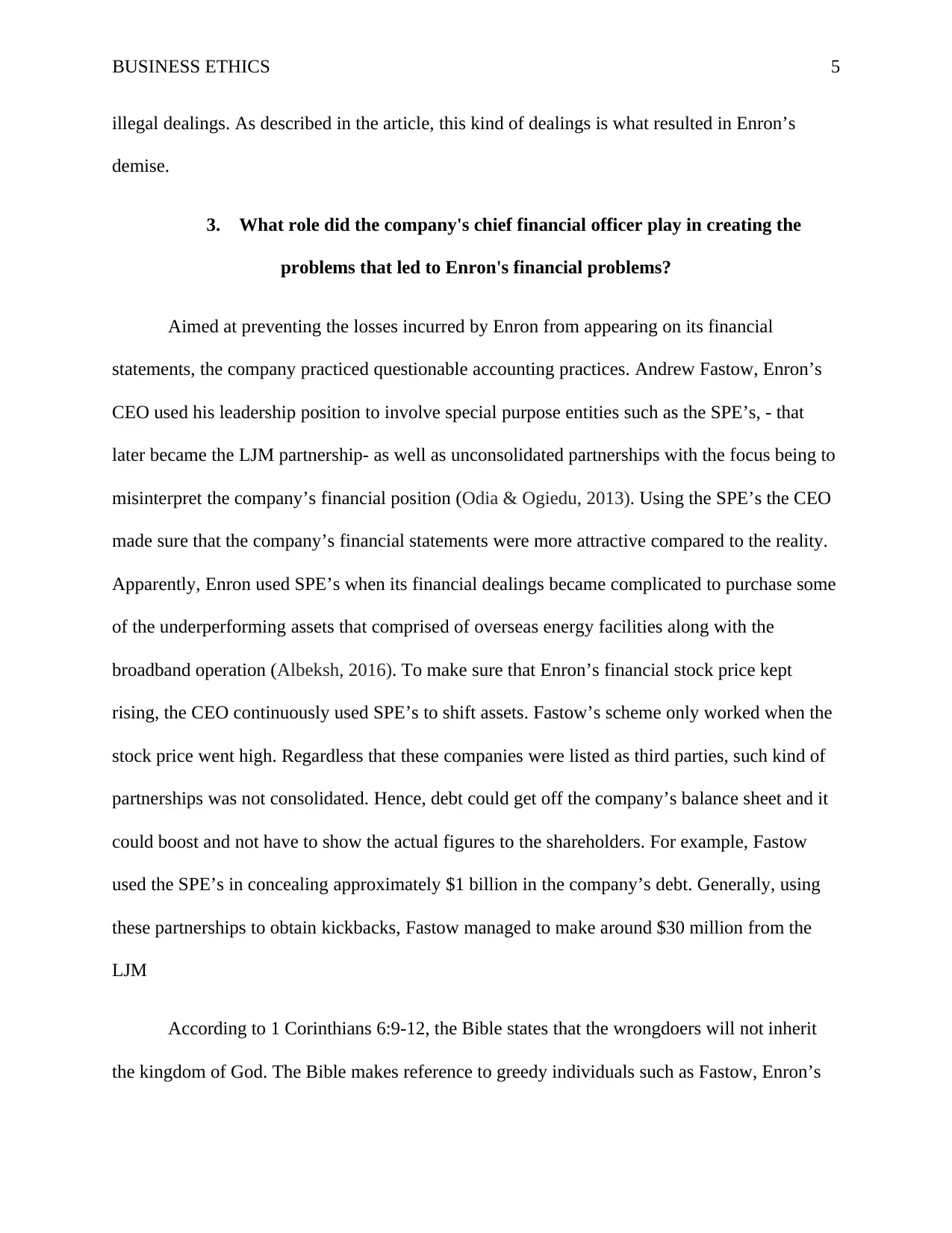
BUSINESS ETHICS 5
illegal dealings. As described in the article, this kind of dealings is what resulted in Enron’s
demise.
3. What role did the company's chief financial officer play in creating the
problems that led to Enron's financial problems?
Aimed at preventing the losses incurred by Enron from appearing on its financial
statements, the company practiced questionable accounting practices. Andrew Fastow, Enron’s
CEO used his leadership position to involve special purpose entities such as the SPE’s, - that
later became the LJM partnership- as well as unconsolidated partnerships with the focus being to
misinterpret the company’s financial position (Odia & Ogiedu, 2013). Using the SPE’s the CEO
made sure that the company’s financial statements were more attractive compared to the reality.
Apparently, Enron used SPE’s when its financial dealings became complicated to purchase some
of the underperforming assets that comprised of overseas energy facilities along with the
broadband operation (Albeksh, 2016). To make sure that Enron’s financial stock price kept
rising, the CEO continuously used SPE’s to shift assets. Fastow’s scheme only worked when the
stock price went high. Regardless that these companies were listed as third parties, such kind of
partnerships was not consolidated. Hence, debt could get off the company’s balance sheet and it
could boost and not have to show the actual figures to the shareholders. For example, Fastow
used the SPE’s in concealing approximately $1 billion in the company’s debt. Generally, using
these partnerships to obtain kickbacks, Fastow managed to make around $30 million from the
LJM
According to 1 Corinthians 6:9-12, the Bible states that the wrongdoers will not inherit
the kingdom of God. The Bible makes reference to greedy individuals such as Fastow, Enron’s
illegal dealings. As described in the article, this kind of dealings is what resulted in Enron’s
demise.
3. What role did the company's chief financial officer play in creating the
problems that led to Enron's financial problems?
Aimed at preventing the losses incurred by Enron from appearing on its financial
statements, the company practiced questionable accounting practices. Andrew Fastow, Enron’s
CEO used his leadership position to involve special purpose entities such as the SPE’s, - that
later became the LJM partnership- as well as unconsolidated partnerships with the focus being to
misinterpret the company’s financial position (Odia & Ogiedu, 2013). Using the SPE’s the CEO
made sure that the company’s financial statements were more attractive compared to the reality.
Apparently, Enron used SPE’s when its financial dealings became complicated to purchase some
of the underperforming assets that comprised of overseas energy facilities along with the
broadband operation (Albeksh, 2016). To make sure that Enron’s financial stock price kept
rising, the CEO continuously used SPE’s to shift assets. Fastow’s scheme only worked when the
stock price went high. Regardless that these companies were listed as third parties, such kind of
partnerships was not consolidated. Hence, debt could get off the company’s balance sheet and it
could boost and not have to show the actual figures to the shareholders. For example, Fastow
used the SPE’s in concealing approximately $1 billion in the company’s debt. Generally, using
these partnerships to obtain kickbacks, Fastow managed to make around $30 million from the
LJM
According to 1 Corinthians 6:9-12, the Bible states that the wrongdoers will not inherit
the kingdom of God. The Bible makes reference to greedy individuals such as Fastow, Enron’s
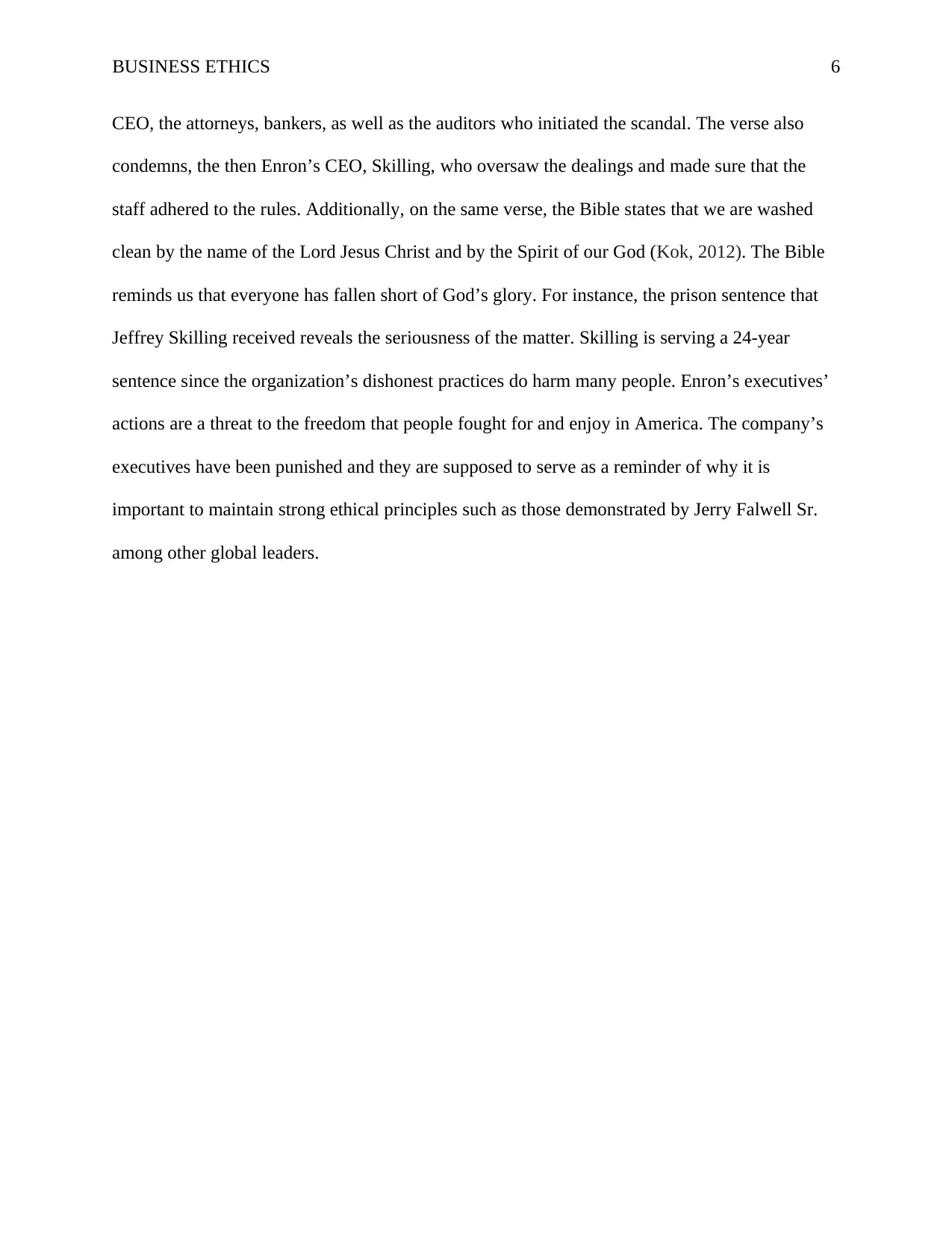
BUSINESS ETHICS 6
CEO, the attorneys, bankers, as well as the auditors who initiated the scandal. The verse also
condemns, the then Enron’s CEO, Skilling, who oversaw the dealings and made sure that the
staff adhered to the rules. Additionally, on the same verse, the Bible states that we are washed
clean by the name of the Lord Jesus Christ and by the Spirit of our God (Kok, 2012). The Bible
reminds us that everyone has fallen short of God’s glory. For instance, the prison sentence that
Jeffrey Skilling received reveals the seriousness of the matter. Skilling is serving a 24-year
sentence since the organization’s dishonest practices do harm many people. Enron’s executives’
actions are a threat to the freedom that people fought for and enjoy in America. The company’s
executives have been punished and they are supposed to serve as a reminder of why it is
important to maintain strong ethical principles such as those demonstrated by Jerry Falwell Sr.
among other global leaders.
CEO, the attorneys, bankers, as well as the auditors who initiated the scandal. The verse also
condemns, the then Enron’s CEO, Skilling, who oversaw the dealings and made sure that the
staff adhered to the rules. Additionally, on the same verse, the Bible states that we are washed
clean by the name of the Lord Jesus Christ and by the Spirit of our God (Kok, 2012). The Bible
reminds us that everyone has fallen short of God’s glory. For instance, the prison sentence that
Jeffrey Skilling received reveals the seriousness of the matter. Skilling is serving a 24-year
sentence since the organization’s dishonest practices do harm many people. Enron’s executives’
actions are a threat to the freedom that people fought for and enjoy in America. The company’s
executives have been punished and they are supposed to serve as a reminder of why it is
important to maintain strong ethical principles such as those demonstrated by Jerry Falwell Sr.
among other global leaders.
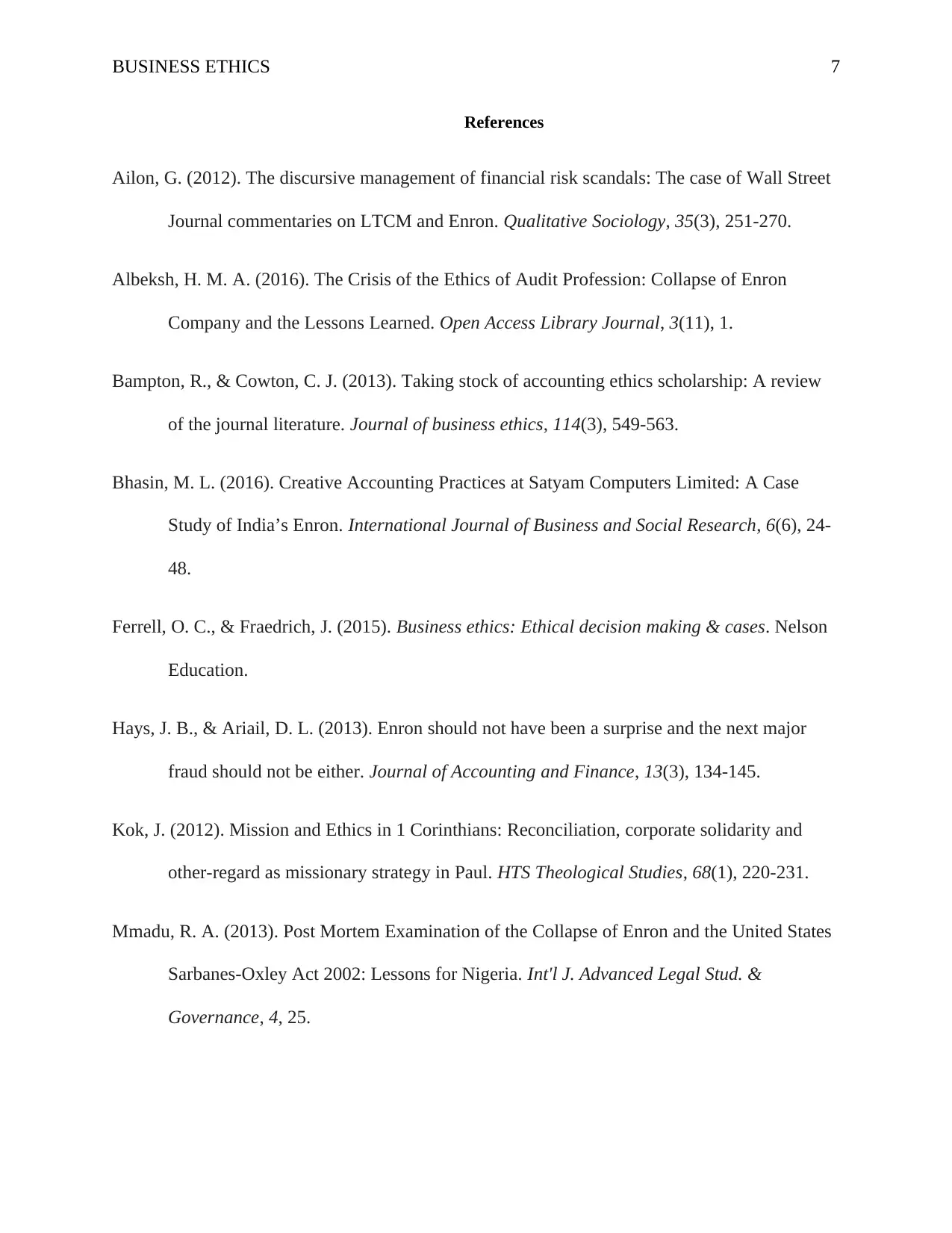
BUSINESS ETHICS 7
References
Ailon, G. (2012). The discursive management of financial risk scandals: The case of Wall Street
Journal commentaries on LTCM and Enron. Qualitative Sociology, 35(3), 251-270.
Albeksh, H. M. A. (2016). The Crisis of the Ethics of Audit Profession: Collapse of Enron
Company and the Lessons Learned. Open Access Library Journal, 3(11), 1.
Bampton, R., & Cowton, C. J. (2013). Taking stock of accounting ethics scholarship: A review
of the journal literature. Journal of business ethics, 114(3), 549-563.
Bhasin, M. L. (2016). Creative Accounting Practices at Satyam Computers Limited: A Case
Study of India’s Enron. International Journal of Business and Social Research, 6(6), 24-
48.
Ferrell, O. C., & Fraedrich, J. (2015). Business ethics: Ethical decision making & cases. Nelson
Education.
Hays, J. B., & Ariail, D. L. (2013). Enron should not have been a surprise and the next major
fraud should not be either. Journal of Accounting and Finance, 13(3), 134-145.
Kok, J. (2012). Mission and Ethics in 1 Corinthians: Reconciliation, corporate solidarity and
other-regard as missionary strategy in Paul. HTS Theological Studies, 68(1), 220-231.
Mmadu, R. A. (2013). Post Mortem Examination of the Collapse of Enron and the United States
Sarbanes-Oxley Act 2002: Lessons for Nigeria. Int'l J. Advanced Legal Stud. &
Governance, 4, 25.
References
Ailon, G. (2012). The discursive management of financial risk scandals: The case of Wall Street
Journal commentaries on LTCM and Enron. Qualitative Sociology, 35(3), 251-270.
Albeksh, H. M. A. (2016). The Crisis of the Ethics of Audit Profession: Collapse of Enron
Company and the Lessons Learned. Open Access Library Journal, 3(11), 1.
Bampton, R., & Cowton, C. J. (2013). Taking stock of accounting ethics scholarship: A review
of the journal literature. Journal of business ethics, 114(3), 549-563.
Bhasin, M. L. (2016). Creative Accounting Practices at Satyam Computers Limited: A Case
Study of India’s Enron. International Journal of Business and Social Research, 6(6), 24-
48.
Ferrell, O. C., & Fraedrich, J. (2015). Business ethics: Ethical decision making & cases. Nelson
Education.
Hays, J. B., & Ariail, D. L. (2013). Enron should not have been a surprise and the next major
fraud should not be either. Journal of Accounting and Finance, 13(3), 134-145.
Kok, J. (2012). Mission and Ethics in 1 Corinthians: Reconciliation, corporate solidarity and
other-regard as missionary strategy in Paul. HTS Theological Studies, 68(1), 220-231.
Mmadu, R. A. (2013). Post Mortem Examination of the Collapse of Enron and the United States
Sarbanes-Oxley Act 2002: Lessons for Nigeria. Int'l J. Advanced Legal Stud. &
Governance, 4, 25.
Paraphrase This Document
Need a fresh take? Get an instant paraphrase of this document with our AI Paraphraser
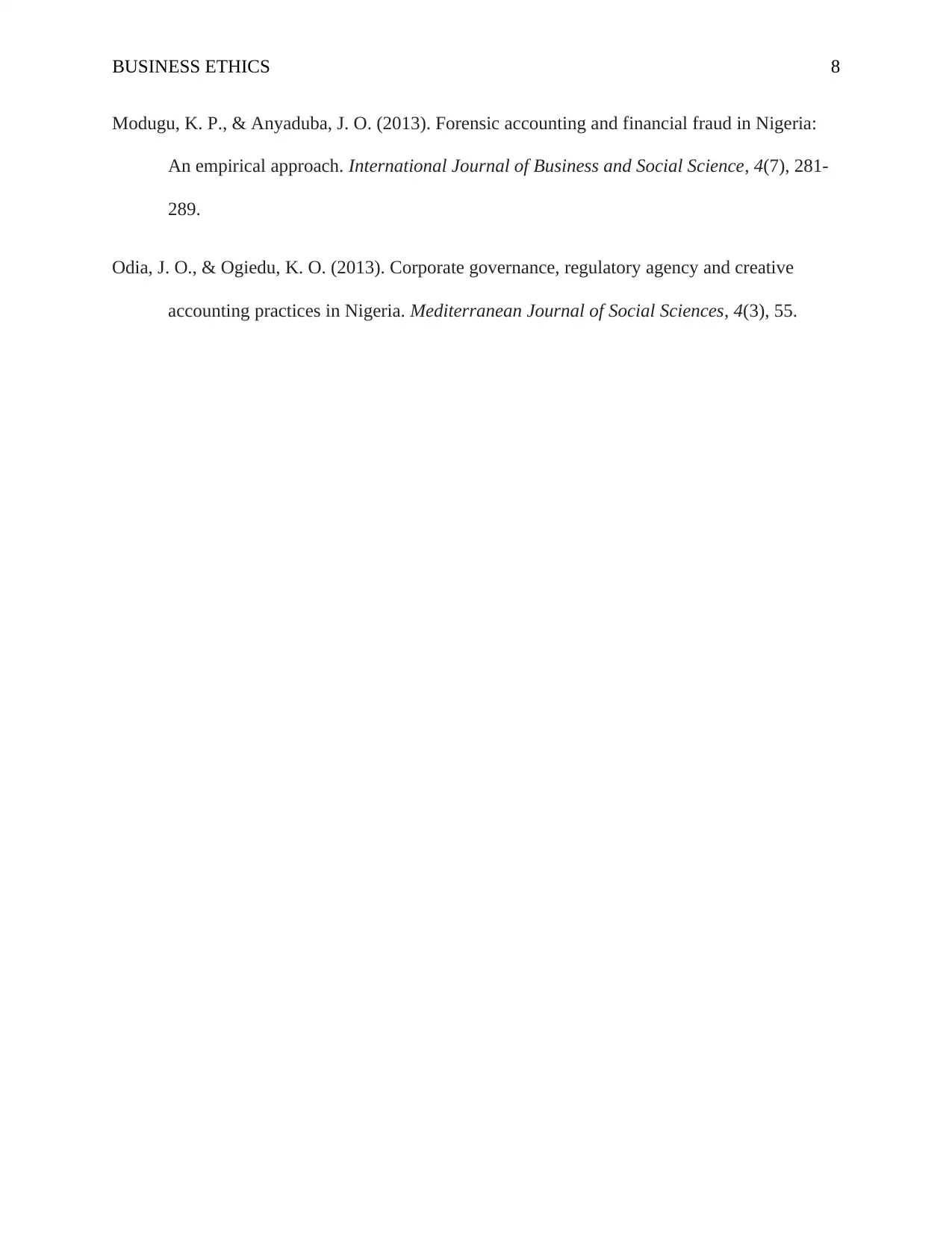
BUSINESS ETHICS 8
Modugu, K. P., & Anyaduba, J. O. (2013). Forensic accounting and financial fraud in Nigeria:
An empirical approach. International Journal of Business and Social Science, 4(7), 281-
289.
Odia, J. O., & Ogiedu, K. O. (2013). Corporate governance, regulatory agency and creative
accounting practices in Nigeria. Mediterranean Journal of Social Sciences, 4(3), 55.
Modugu, K. P., & Anyaduba, J. O. (2013). Forensic accounting and financial fraud in Nigeria:
An empirical approach. International Journal of Business and Social Science, 4(7), 281-
289.
Odia, J. O., & Ogiedu, K. O. (2013). Corporate governance, regulatory agency and creative
accounting practices in Nigeria. Mediterranean Journal of Social Sciences, 4(3), 55.
1 out of 8
Your All-in-One AI-Powered Toolkit for Academic Success.
+13062052269
info@desklib.com
Available 24*7 on WhatsApp / Email
![[object Object]](/_next/static/media/star-bottom.7253800d.svg)
Unlock your academic potential
© 2024 | Zucol Services PVT LTD | All rights reserved.
